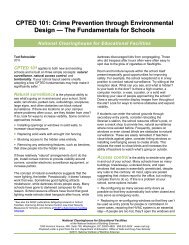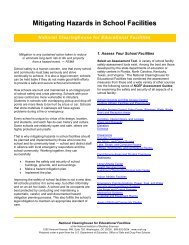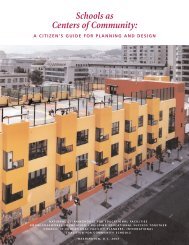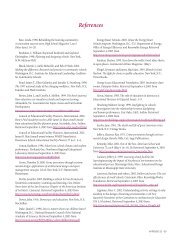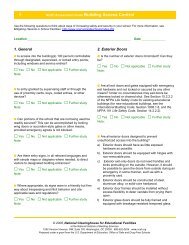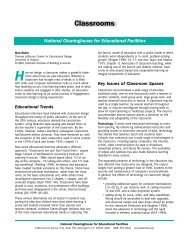Educational Facilities Disaster and Crisis Management Guidebook.
Educational Facilities Disaster and Crisis Management Guidebook.
Educational Facilities Disaster and Crisis Management Guidebook.
You also want an ePaper? Increase the reach of your titles
YUMPU automatically turns print PDFs into web optimized ePapers that Google loves.
PREPAREDNESS<br />
facilities project manager to implement contractor tiedown<br />
procedures.<br />
# All objects that may be blown by the wind should be<br />
taken into the building (e.g., garbage cans, lawn<br />
furniture). Anchor objects that cannot be brought<br />
inside. Also, check the roofs of buildings for loose<br />
objects.<br />
# Clean out all gutters <strong>and</strong> roof drains. One gallon of<br />
water weighs 8.35 pounds; the weight from backedup<br />
water adds up quickly <strong>and</strong> can easily cause a roof<br />
collapse.<br />
# Remove <strong>and</strong> relocate all portable physical education<br />
equipment to the interior of the school.<br />
# Lower <strong>and</strong> secure window storm awnings (if<br />
applicable).<br />
# Close all windows.<br />
# Take down <strong>and</strong> properly store all cloth coverings<br />
from exterior of the site.<br />
# Pools:<br />
» Lower the water level of swimming pools one foot<br />
to accommodate heavy rains, but do not drain<br />
them completely.<br />
» Add extra chlorine to pools to prevent<br />
contamination.<br />
» Turn off electricity to pool equipment.<br />
# Check generator <strong>and</strong> emergency lights (if<br />
applicable).<br />
# Media Area/Computer Labs - If possible, relocate all<br />
equipment to tabletops <strong>and</strong> cover with plastic to<br />
reduce water damage.<br />
# Media Area - Relocate any valuable books in the<br />
collection to the upper shelves.<br />
34



